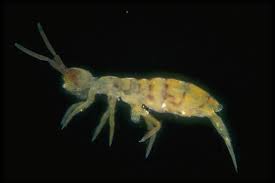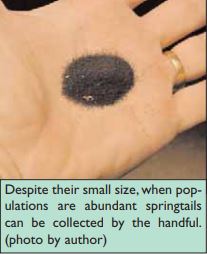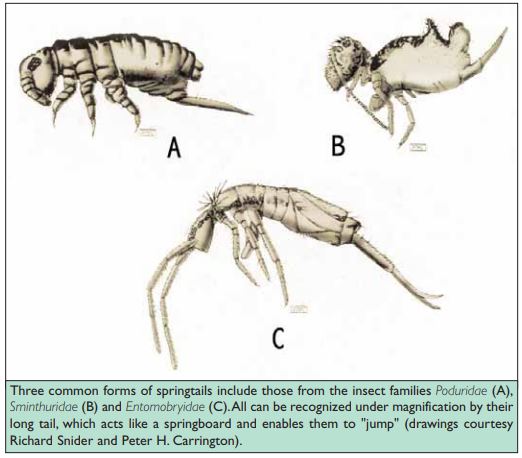Springtails
By: Michael Merchant and Mark Muegge

You undoubtedly have springtails (a lot of them!) in and around your home and garden, yet the odds are you know little about them because they are so small and secretive. Springtails are common insects that live in leaf litter, compost piles and lawn soils, recycling dead plant material into nutrients to fertilize your lawn. Only about a millimeter long, springtails are rarely seen, but given the right environmental conditions, they can multiply to become a nuisance.
Springtails are not harmful. They do not bite people or pets, spread disease or damage homes or household items. Nevertheless, most people don’t want them in their homes. Their presence alone makes them pests!
Recognizing Springtails
If it’s very small and jumps, it’s probably a springtail.
The smallest springtails, 0.2 mm long, are among the world’s tiniest insects, while the largest springtails reach a length of only 10 mm (3⁄8 inch). Most are between 1 and 2 mm long. Springtails have six legs, short antennae with four to six segments and soft, elongated or roundish bodies. Most have only small, rudimentary eyes.

Approximately 700 different species of springtails live in North America. Many different kinds can be found in a typical backyard. Springtails have scales that are usually creamy white or gray, but some species may appear yellow, orange, metallic green, lavender or red.
The name springtail comes from the insect’s forked tail, called a furculum, which is found on most species. Normally a springtail holds its furculum under its body, but when disturbed will extend it quickly, jumping an inch or farther (for the larger species).
Underground species are less than 1 mm long and may not have a furculum. Under magnification, these non-jumping springtails can be positively identified by a tube-like structure (called a collophore) on the underside of the first segment of the abdomen. Found in all springtails, the collophore is believed to help with water uptake.
Springtails can be distinguished easily from fleas, which are black or brown, teardrop-shaped and flattened on their sides. Adult fleas actively jump onto people and pets and bite them; springtails do not bite.
Biology and Habits
Springtails eat bacteria, fungi, lichens, algae and decaying vegetation, fertilizing the soil in the process. Some feed on carrion, and a few carnivorous species eat other springtails and small invertebrates. Some species eat plant roots or nibble on tender young plants, occasionally damaging potted or greenhouse plants. In most cases, however, springtails benefit plants; for example, certain species help spread beneficial fungi on plant roots.
The numbers of springtails rise and fall with fluctuations in temperature, moisture and food availability. Springtails thrive in shady areas rich in decaying leaves and humus, but they can abound even in urban lawns. A cubic foot of soil may harbor 10,000 individuals, with millions found in a single backyard. Common species are thought to reproduce several times each year. With such high reproductive rates, populations can increase quickly when weather is favorable.
Springtails will crawl up the sides of houses and enter them through gaps between bricks or around doors and windows, with hundreds of springtails suddenly appearing indoors. Once inside a home, springtails usually die quickly from low humidity and lack of food, so they cannot be transferred from one house to another in boxes or on clothing. However, springtails can live a long time on indoor potted plants or infest buildings with high humidity.
Large numbers of springtails also may fall into swimming pools, where their waterproof bodies float on the surface, resembling pollen or algae. Skimmer nets used to clean pools may appear alive with crawling, hopping masses of the insects.
Management
Springtails reproduce quickly with abundant food, humidity and habitat. Outdoors, some springtail species can live in dry environments, such as around urban sidewalks and buildings, but most species need moisture to thrive. Irrigation or rainwater suddenly filling soil pores may flush springtails to the surface or promote the growth of food to boost springtail populations. To reduce numbers of springtails outdoors, reduce watering or, on turfgrass, irrigate no more than once a week, watering soil deeply each time to at least 1 inch penetration.
To keep springtails from invading a home, use caulk or expanding foam to seal cracks or gaps where insects can enter. Check and replace door seals as needed, and use foam weatherproofing strips to seal windows.
Pesticide treatments for outdoor infestations usually produce mixed results, although applying residual insecticides (such as permethrin, tralomethrin, bifenthrin, cyfluthrin, lambda cyhalothrin or carbaryl) around structures provides some control. Tips for keeping springtails out of your home include:
- Rake mulches about 1 foot away from building foundations before treatment.
- Wait a few days to several weeks (depending on weather) for an infestation to run its course.
- Apply insecticides around the foundation perimeter, extending the application 5 to 10 feet from the house (after raking mulch 1 foot away from foundation).
- Apply pesticides to possible entry points around windows and doorways, under siding and at other openings in brick or wood walls.
If you have a chronic, long-lasting indoor springtail infestation, it may be because the insects are living in potted plants or moist areas in walls or storage areas. Where there is moisture, fungal growth can sustain infestations. Springtails may infest wells, toilet bowl tanks, wet insulation, drains, moist basements and damp walls. To control indoor infestations, (1) remove the dampness and organic matter causing the problem; (2) vacuum up springtails; or (3) kill them with short lived pesticides such as pyrethrins or allethrin.

Springtails for Science
Because they are easy to collect and to keep, springtails make excellent science fair projects. Students can study springtail interaction and their food, temperature and moisture preferences.
How to collect
Springtails are easy to collect from leaf litter, soil and compost.
- Replace the bottom of a coffee can or plastic jar with ¼-inch hardware cloth (screen).
- Put into your can or jar a small amount of the material you wish to sift for insects.
- Place a container with a sponge or wetted plaster underneath the screened jar or can to catch springtails and other critters.
- Place a lamp or other low-heat source above the can. Heat from the light bulb will dry the leaf litter from the top, driving springtails and other small invertebrates through the screen at the bottom.
You can also collect springtails by sweeping a cooking pot or white enamel bowl through grass or other vegetation. Put a small amount of water in the pan to concentrate insects into a manageable cluster. Then dump or rinse the insects through a porous fabric, such as a handkerchief, to prevent them from jumping away.
How to keep
Use these suggestions to keep your springtails alive and well.
- Make a rearing container by pouring an inch of plaster of Paris into the bottom of an empty plastic container and allowing it to dry. To trap contaminants, add a small amount of ground-up activated charcoal (like that used in aquarium filters) to the plaster.
- After the plaster has dried, wet its surface to maintain high humidity in the container.
- Keep springtails in this container with a small amount of food. Although in captivity they will eat just about anything, springtails thrive on live or dried whole yeast. Sprinkle in a little yeast at a time, with an occasional bit of algae.
- Test other food sources, such as mold growing on bread. If you have access to a school laboratory, try growing various fungi on agar plates for additional tests.
- Because springtails are delicate and may be damaged by rough handling, transfer them between cages with a fine brush or an aspirator, which can be made or purchased through a biological supply house.
Download a printer-friendly version of this publication: Springtails (PDF)
